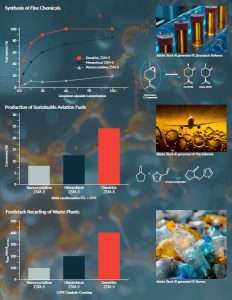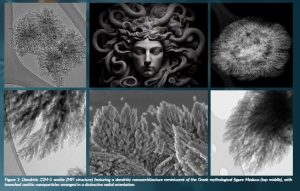TODENZE project opens the gate of highly accessible zeolites exhibiting dendritic nanoarchitecture
Principal investigator of the TODENZE project, Professor David P. Serrano, and his team have developed an innovative synthesis route leading to highly accessible zeolites featured by possessing both dendritic nanoarchitecture and multilevel porosity.
TODENZE is an ERC Advanced Grant project aiming to provide fundamental insights into the formation of dendritic zeolites and to explore the benefits of these materials in various fields, mainly as catalysts in biomass valorisation into both advanced biofuels and biobased chemicals and as carriers for drug and gene therapies.
Zeolites, known for their crystalline microporous structure, have become crucial materials in strategic sectors, including oil refining, petrochemistry, fine chemical production and environmental remediation. Their unique properties— such as high crystallinity, extensive surface area, adjustable hydrophobic/ hydrophilic characteristics, uniform micropores, strong acidity, shape selectivity and hydrothermal stability—have made them very effective catalysts, adsorbents, supports and ion-exchange agents. With advancements in synthesis and structural analysis, more than 250 different zeolite frameworks have been identified to date. However, their small pore sizes, typically under 1 nm, limit their use with large molecules.
To address this, research over the past 20 years has focused on developing zeolites with enhanced accessibility, including nanocrystalline forms, hierarchical structures with both micro- and mesopores, and 2D nanosheet configurations. These innovative zeolite materials often outperform traditional ones, promising even greater commercial potential in the future.
Objective: dendritic zeolites
Before the emergence of dendritic zeolites, dendritic fibrous nanoparticles (DFNPs) have revealed themselves as the ‘rising stars’ of amorphous silica materials. Their unique morphology, characterised by fibrous branches extending from the core to the surface of the particles, provides them with exceptional accessibility. However, their inherently amorphous nature often hinders their use under conditions typically encountered in industrial applications.
The main objective of the TODENZE project is the development of crystalline dendritic materials possessing a zeolitic structure that may combine the singular properties of amorphous dendritic materials and conventional zeolites.
Dendritic ZSM-5 zeolite: the first of its kind
The synthesis of dendritic ZSM-5 zeolite (MFI structure) was reported in 2023 as one of the outcomes of the TODENZE project, becoming the first zeolitic structure featuring a dendritic nanoarchitecture reminiscent of the Greek mythological figure Medusa. The particles in dendritic ZSM-5 consist of aggregates of very small zeolitic nano units (about 5–10 nm) showing a distinctive radially-oriented and branched configuration, similar to that encountered in biomimetic materials.
This singular morphology confers dendritic ZSM-5 zeolite with unique properties compared with other accessible ZSM-5 variants, such as nanocrystalline or hierarchical zeolites.
Thus, dendritic ZSM-5 exhibits very high mesopore/external surface areas (up to 400 m2/g), a large total pore volume (up to 1 cm3/g) and an outstanding interconnectivity of the porous network consisting of zeolitic micropores, dendritic mesopores and internal large vesicles. Their remarkable set of properties is enhanced by their balanced Brønsted to Lewis acid site concentration ratio.
Outstanding results compared with previous accessible zeolites
These properties open the door to a wide variety of applications where other versions of ZSM-5 fail to deliver significant results. To date, dendritic ZSM-5 zeolites have shown outstanding performance in catalytic applications that involve processing or the production of bulky molecules, such as for low-density polyethylene cracking, for waste plastic feedstock recycling, aldol condensation reactions to produce precursors of sustainable aviation fuels, limonene epoxide isomerisation to yield intermediates for fine chemicals and in the methane decomposition for hydrogen generation. In addition, this material has proven to be an interesting adsorbent of volatile organic compounds (VOCs). The performance of dendritic ZSM-5 in these relevant applications far surpasses those achieved by conventional reference materials.
Future perspectives
Next steps of the TODENZE project include incorporating other heteroatoms into the structure instead of aluminium and synthesising other zeolitic structures beyond the MFI framework. This promises a bright future not only for the use of dendritic zeolites as catalysts in reactions involving bulky molecules for waste valorisation or sustainable fuel production but also as a support material for drug delivery and gene therapy—the next goal of the TODENZE project.
The potential of the results so far obtained in the TODENZE project extends beyond applications to synthesis itself. Thus, another objective, will be evaluating the feasibility of the cost reduction of the synthesis process, as well as the lowering of its environmental impact, in order to address the challenges for the optimised potential industrial scaleup of the synthesis methodology. This would pave the way for large-scale production of these materials and their future industrial use.
Related publications
Alonso-Doncel, M. del M., Ochoa-Hernández, C., Gómez-Pozuelo, G., Oliveira, A., González- Aguilar, J., Peral, Á., Sanz, R. and Serrano, D.P. (2023) ‘Dendritic Nanoarchitecture Imparts ZSM-5 Zeolite with Enhanced Adsorption and Catalytic Performance in Energy Applications’, Journal of Energy Chemistry, 80, pp. 77–88. doi: 10.1016/j.jechem.2023.01.023.
Alonso-Doncel, M. del M., Giner, E.A., de la Calle, D., Cueto, J., Horcajada, P., García-Muñoz, R.A., and Serrano, D.P. (2023) ‘Synthesis of Dendritic ZSM-5 Zeolite through Micellar Templating Controlled by the Amphiphilic Organosilane Chain Length’, Crystal Growth and Design, 23(8), 5658– 5670. doi: 10.1021/acs.cgd.3c00326.
Gallego-Villada, L.A., Perez-Sena, W.Y., Sánchez-Velandia, J.E., Cueto, J., Alonso-Doncel, M. del M., Wärnå, J., Mäki-Arvela, P., Alarcón, E.A., Serrano, D.P. and Murzin, D.Y. (2024) ‘Synthesis of dihydrocarvone over dendritic ZSM-5 Zeolite: A comprehensive study of experimental, kinetics, and computational insights’, Chemical Engineering Journal, 498, 155377. doi: 10.1016/j. cej.2024.155377.
Gallego-Villada, L.A., Cueto, J., Alonso-Doncel, M. del M., Mäki-Arvela, P., Alarcón, E.A., Serrano, D.P. and Murzin, D.Y. (2024) ‘Dendritic ZSM-5 zeolites as highly active catalysts for the valorization of monoterpene epoxides’, Green Chemistry. Advance Article. doi: 10.1039/D4GC04003A.
Project name
TODENZE – Opening the Pathway Towards Dendritic Zeolites
Project summary
The ERC Advanced Grant TODENZE project aims to develop a new type of highly accessible zeolites exhibiting a dendritic nanoarchitecture, which could provide remarkable benefits in a wide range of fields. In particular, the project explores the use of dendritic zeolites as catalysts for biomass valorisation and as nanocarriers for combined drug and gene therapies.
Project lead profile
D.P. Serrano is Director of the IMDEA Energy Institute (2007–present) and Full Professor of Chemical Engineering at Rey Juan Carlos University (2002–present). PhD in Industrial Chemistry (Complutense University of Madrid, 1990). Associate Professor at Complutense University of Madrid (1993–1998) and Rey Juan Carlos University (1999–2001). Visiting Associate at the California Institute of Technology (1991) and the California University at Santa Barbara (2006). In 2007, he was appointed as Director of the IMDEA Energy Institute, created as a completely novel institution. He is responsible for its definition, planning, development, and management.
His research topics have been mainly focused on the development of catalytic materials for a number of applications, such as plastic waste chemical recycling, transformation of biomass residues, clean hydrogen production and CO2 valorisation. Author of about 275 scientific articles (h-index=72, Scopus).
Project contacts
IMDEA Energy Institute
+34 917 37 11 20
Email: david.serrano@imdea.org
Web: https://energia.imdea.org/
Web: https://todenzeproject.com/
Funding
This project has received funding from the European Research Council (ERC) under the European Union’s Horizon 2020 research and innovation programme under grant agreement No. 101021502.
Figure legends
Figure 1: Dendritic ZSM-5 zeolite (MFI structure) featuring a dendritic nanoarchitecture reminiscent of the Greek mythological figure Medusa (top middle), with branched zeolitic nanoparticles arranged in a distinctive radial orientation.



